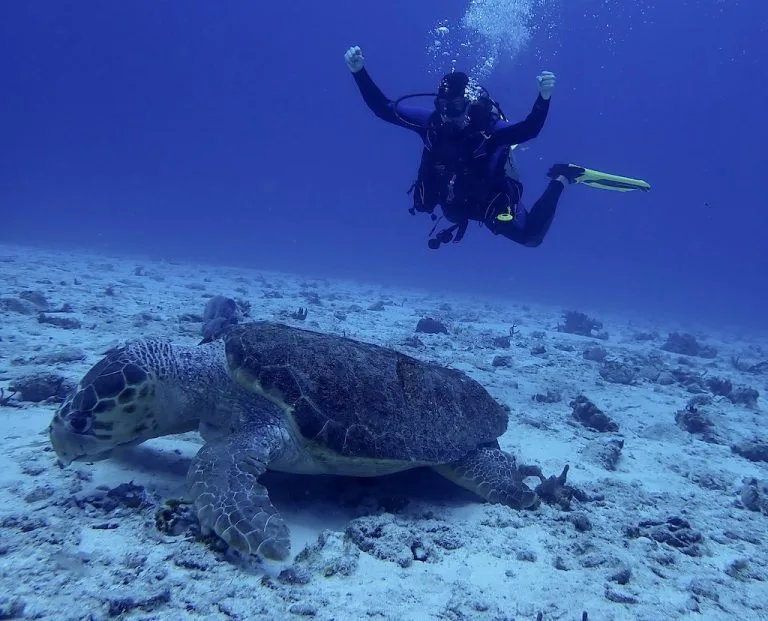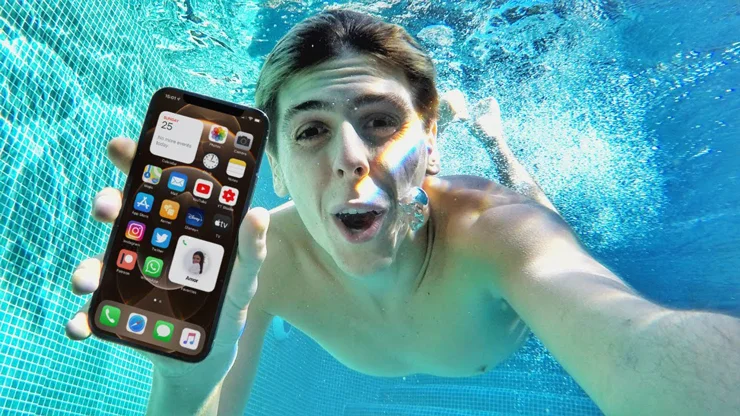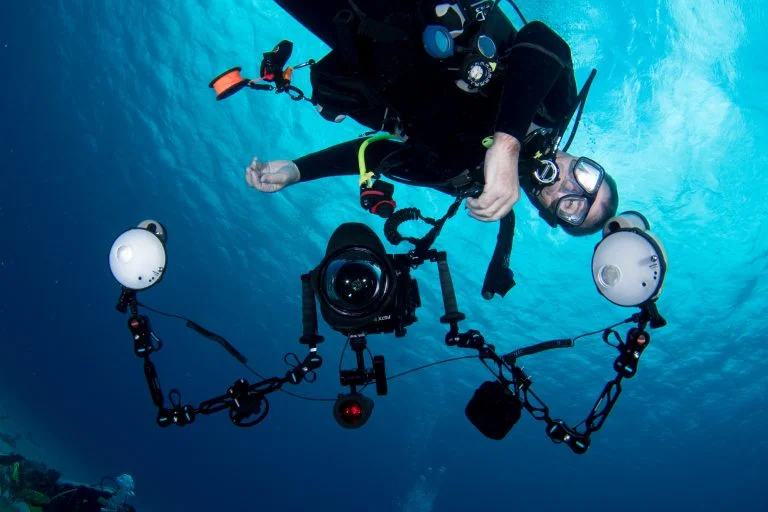If you’re a true beginner with underwater photography and struggling to get decent pictures, go easy on yourself! Underwater photos are tricky, especially if you don’t have a strong background in photography starting out.
These simple, non-techy underwater photography tips should help you get better results underwater, to level-up your diving photography and gain some added confidence.
That confidence boost, plus time and practice, will improve your dive photos in no time.
- Need Advice on What Underwater Camera Equipment to Buy?
- Enjoy Your Underwater Photography as a Hobby
- Choose Easy Underwater Photo Subjects
- Learn More About Marine Life to Improve Your UW Photography
- Better Backgrounds in Underwater Photos
- Create Eye-Contact in Marine Life Photos
- Make Sure Your Diving Skills Are Dialed-In Before Picking Up An Underwater Camera
- Buy The Best Underwater Camera Set-Up For You
- Underwater Photography: The Long Game
Need Advice on What Underwater Camera Equipment to Buy?
Please note: for the purposes of this post, I’m assuming you’ve already used your underwater camera and housing at least a few times (and perhaps been disappointed in the results).
BUT, if you are truly just starting out and need advice on what camera or marine housing to purchase, then we’re just as excited as you! Please keep reading for some great advice on choosing your first underwater photography equipment, a few paragraphs below.
If you don’t need any beginner underwater photography tips, and want to skip right to the fun stuff (photography gadgets and gear, of course!), then link to this super helpful post on choosing the underwater camera equipment that’s right for you, right now: right here.
Enjoy Your Underwater Photography as a Hobby
My first clear simple tip for better underwater photos when you’re just starting out is to relax. Relax both with your diving and your dive photography.
I’d wager the vast majority of people who take up scuba diving don’t have a technical background in photography.
Most people I meet who are picking up the waterproof camera for the first time started out because they wanted to learn to dive and then fell in love with dive travel and exploring underwater.
Once they experience the awe of the underwater world, though, many new divers can’t wait to get an underwater camera so they can share diving images and talk about what they’ve seen – either among fellow scuba divers or with their family and friends.
And often, this is when unnecessary stressors arise.
Depending on where you seek help and advice, you may feel pressure to buy a full kit of fancy gear before you even really understand what you’re doing. Or you may be overwhelmed by online articles full of technical photography information on colored filters, wet lenses, camera specifications, and underwater optics.
We’re also very quick to criticize our early images or compare them to the beautiful (and very skilled professionals’) underwater photos we’ve seen in high-quality nature and scuba diving magazines.
But let’s be real – it’s pretty complicated at first! Go easy on yourself.
After all, you’re not just taking nice vacation photos. You’re also managing ocean currents and surge, operating new underwater camera gear, and meanwhile being very mindful of your depth and your air consumption and your buddy and your group and, last but not least, not damaging the coral reef and the resident marine life (and please never forget that those things come first and foremost).
In this hobby, even more than many others, getting better takes time. There’s just no escaping the old saying that practice makes perfect.
Luckily, most of the practice is taking place on awesome dives – and hopefully in fun and interesting locations.
Don’t let that shiny new underwater camera in your hand turn a new love of scuba diving and underwater exploration into a source of frustration and disappointment. Always remind yourself you are diving! In the beginning just relax and enjoy the overall experience and learning process.
Choose Easy Underwater Photo Subjects
If you’re here, I think you’ll agree that diving is awesome.
You never know when you’re going to have that chance encounter with a shark, or rare species, or something that you’ve never seen before. With camera in hand, you can capture those moments and get bragging rights with your fellow divers and some folks back home.
That said, in between those undeniable “highlight encounters,” my main advice is to make a conscious effort to experiment with taking shots of underwater marine life that is easier to capture.
First off, it’s less frustrating. As you get some beautiful shots of textures, corals, and other slow-moving animals, you’ll feel some “quick wins” and some images worthy of your social media feeds. That goes a long way and gives your confidence a boost.
Secondly, half the battle with underwater photography is experimenting with angles and lighting, and easier subjects will let you do just that.
A reef shark is not going to hang around while you take 3 or 4 additional frames to try a new setting or adjust your own positioning in the water column. But a brittle star will!
Finally, if you pick a few easy and plentiful favorites to take pictures of repeatedly, over time you’ll clearly see your progression and improvement.
In a previous article here on the Moziak blog, I make a case for shooting lots of pictures of the many marine crabs you’ll find as a new diver.
There are various sizes and types of crabs everywhere you look along the coral reefs, and they range greatly in shape, color, typical location, and even behavior.
It still takes a deft eye and hand to get great shots of crabs, so the challenge is there. But they’re also all around you, so you can continually practice much more easily and during nearly every dive.
Taking on something specific like this as a side challenge will not only give you more chances to practice your underwater photography, but it will also help you learn more about the various crabs on the reefs, as well as their hosts and habitats.
Or pick a different species if you want! The point is to identify some underwater photo subjects that you have easier access to and can practice with, over and over. You’ll get better at fine-tuning your newbie skills of mastering your camera, achieving the right distance, framing your shot, use of ambient or flash lighting, and so on.
Plus, you’ll have a series of more “apples-to-apples” images where you can really see a progression your own improvement over time.
Learn More About Marine Life to Improve Your UW Photography
This goes hand in hand with the tip, above.
It may seem silly or obvious, but it’s something that a lot of new divers don’t always appreciate. I encounter a lot of beginner underwater photographers who want to get better images but are solely interested in big (and fast moving) sharks, rays, and sport fish. If you start to talk about cool behavior or the awesome anatomy of some “lesser” marine-life species, their eyes kinda glaze over and they lose interest.
With more diving time, though, you’ll naturally start to notice the amazing variety of creatures – great and small – that live underwater. You’ll also learn and sense which animals are rare and which are more common.
Or which animals avoid humans or get spooked easily, as opposed to those that don’t seem to mind if you’re around. (hint: take pictures of the latter for more satisfying practice).
As you’re getting into underwater photography, the more you consult species ID books, or browse the internet for information on the area you’re diving, its terrain, and types of marine animals that live there, the more prepared you’ll be to be on the lookout for great shots as a newbie underwater photographer.
Better Backgrounds in Underwater Photos
In the beginning, it’s fine to just take what comes. When you find something curious or beautiful or interesting, by all means shoot away. Be sure to stay with your dive group, of course, but after that, the only real limitation is your memory card!
Over time, you’ll likely start to gravitate towards subjects that interest you, discover new creatures and find new ways of looking at things through your unique underwater photography eyes.
As you get more and more confident – and competent – you’ll have the ability to anticipate your shots and start to get better at framing your subject.
Rather than settling only for the first sea slug you find on the sand…
…you might wait for the opportunity to capture one that is climbing and posed much more dramatically, on a more rich and colorful background.
A huge part of all of this is not only finding a good subject (which is easier when you know where they tend to hang out), but mindfully creating a composition of a good subject on a good background. This shift in mindset will really improve the overall richness and visual interest of your underwater photographs.
Create Eye-Contact in Marine Life Photos
A common mark of the newbie underwater photographer is that all of the images are shot from a purely “top, down,” overhead view.
I hesitate to call this a “mistake” at this point, because when in doubt in your early days, it’s FAR better to maintain a safe distance from marine life, than to lose control and damage the reef or disrupt the living habitats along the rocky and sandy bottom areas.
Bonus Tip: Lots of beginners (and unfortunately, seasoned underwater photographers, too) tend to disregard the care for the coral reef environment, and their fellow divers, when they have underwater camera gear in their hands. Don’t be that guy. (see a great related article on underwater photography etiquette, here).
All that said, top-down images are a fine place to start, but your goal is to have the skill and versatility to move on from there.
Just like when you’re taking photos of your family and friends, you ideally want to create eye contact or an artful profile with your underwater subjects. Try to capture the essence of that creature.
Whenever possible, it makes a big difference to shoot an underwater subject from eye-level, or even from below.
See the difference between these two beginner eel shots:
Which would you say has more visual interest?
The goal is to have a “moment” with your subject, in my opinion – but just NOT at the expense of the marine environment. If you can’t get in a low position without touching anything, it’s just not your shot, for now.
And if you have to (or choose to!) shoot from the top, down (after all, there are lots and lots of awesome bottom dwellers that make for very cool images…), try wait for a fun candid moment when the animal is displaying unique behavior, or interaction with another animal or object.
Make Sure Your Diving Skills Are Dialed-In Before Picking Up An Underwater Camera
I know you’ve read it many times before, including above, but it is a pretty hard truth that really can’t be overstated.
If you are still fine-tuning your diving skills and mastery of underwater buoyancy, then it is highly unlikely you’ll get any good underwater pictures yet.
You might get lucky here and there, but more likely you’ll just reinforce sloppy diving fundamentals, potentially kick or touch the coral reef or marine life environment, and likely annoy your fellow divers by forgetting any sense of diving etiquette in your excitement.
Newbie underwater photographers are known to focus solely on the camera’s viewfinder while letting diving skills and an appreciation for our surroundings go right out the window.
The sooner you nail your buoyancy and know how to keep your fins up, and yourself and your gear off the bottom, the sooner you’ll be able to walk and chew gum at the same time.
And once you’re a solid diver? By all means try this fun and challenging hobby. It will give you a whole new appreciation for the beauty and complexity of the underwater environment.
Buy The Best Underwater Camera Set-Up For You
Again, I’ve assumed if you’re here, you’ve tried some underwater photography and gotten some frustrating results.
If you’re still mulling it over and need some trusted advice on how to choose your first underwater camera and housing, link to this Moziak post, here for great advice on what to buy.
For those of you who already love underwater photography and want to upgrade your underwater camera gear, you should definitely jump to this recent article on the best underwater camera kits in 2021, next.
Underwater Photography: The Long Game
In sum, when you’re starting out in underwater photography, the best thing you can do is to just relax. You scare away fewer fish, and you will take your progress in stride – all the while enjoying where you are and what you’re experiencing. It is still diving, after all.
Let yourself experiment, but never sacrifice your buoyancy skills for a good photograph.
And don’t kick yourself when you screw up your “one chance” for “that one shot” of “that one shark.”
Like that noisy and poorly framed shark shot, above. Ooopsie.
If you love diving and you make an effort to get in the water as much as you can, there will be other sharks in the future. I (now) have no doubt.
In the meantime, appreciate the ride.
Try to take more pictures of things you do see a lot, so you can practice and grow in your understanding of your equipment, playing with underwater light, and the array and behaviors of the countless marine animals – including corals – in the area where you’re diving.
This skill and knowledge base will grow, and eventually come together and form a steady and satisfying foundation for your underwater photography hobby. And give you the experience and confidence when selecting new dive destinations, or when selecting new strobes, video lights, and other cool gear to your underwater photography kit.




